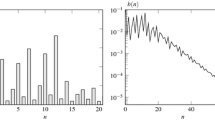
Overview
Part of the book series: The Springer International Series in Engineering and Computer Science (SECS, volume 205)
Access this book
Tax calculation will be finalised at checkout
Other ways to access
About this book
Discrete-Time Models for Communication Systems Including ATM provides a general framework for queueing analyses of dicrete-time systems. After a brief look at past studies of discrete-time systems, a detailed description and analysis are presented for a generic discrete-time model with a single server, arbitrary service times and independent arrivals. The book then follows a less stringent approach and focuses more on the average statistics and on different queueing disciplines. Conventional first-in-out and last-in-first-out disciplines are discussed in terms of the average statistics. Systems with multiple classes of messages without class-dependent priorities are considered to establish a discrete-time conservation law. Multiple classes with priorities are also considered to derive performance measures of priority scheduling disciplines. Finally, a multi-queue system with cyclic service is analyzed in the context of round-robin service ordering.
This is followed by analyses of discrete-time queueing systems with `more complicate' input and output processes. Specifically, single-server systems are investigated whereby either the arrivals or the server is subject to random interruptions. Results are mainly obtained in terms of generating functions and mean values of the principal performance measures. The influence of the nature of the arrival correlation and the server interruptionson the queueing behavior is discussed. Finally, the book explores queueing models directly associated with ATM switches and multiplexers.
This book is a valuable reference and may be used as a text for and advanced course on the subject.
Similar content being viewed by others
Keywords
Table of contents (4 chapters)
-
Front Matter
-
Back Matter
Authors and Affiliations
Bibliographic Information
Book Title: Discrete-Time Models for Communication Systems Including ATM
Authors: Herwig Bruneel, Byung G. Kim
Series Title: The Springer International Series in Engineering and Computer Science
DOI: https://doi.org/10.1007/978-1-4615-3130-2
Publisher: Springer New York, NY
-
eBook Packages: Springer Book Archive
Copyright Information: Springer Science+Business Media New York 1993
Hardcover ISBN: 978-0-7923-9292-7Published: 31 December 1992
Softcover ISBN: 978-1-4613-6370-5Published: 27 September 2012
eBook ISBN: 978-1-4615-3130-2Published: 06 December 2012
Series ISSN: 0893-3405
Edition Number: 1
Number of Pages: XI, 200
Topics: Electrical Engineering, Signal, Image and Speech Processing
